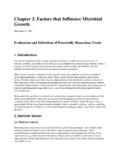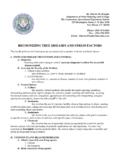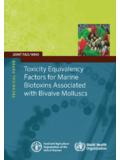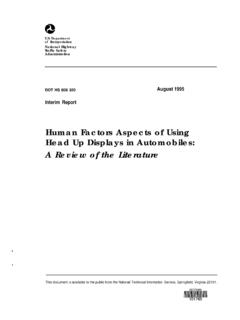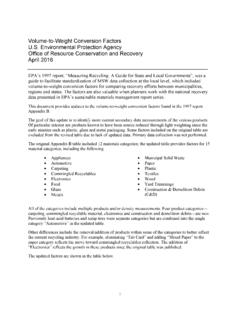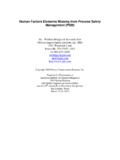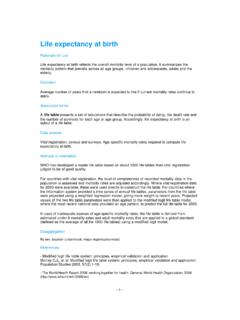Transcription of HUMAN FACTORS FOR DESIGNERS OF EQUIPMENT …
1 Ministry of Defence INTERIM. Defence Standard 00-25 (PART 5) / ISSUE 1 29 M a y 1 9 9 2. HUMAN FACTORS . FOR DESIGNERS OF EQUIPMENT . PART 5: STRESSES AND HAZARDS. INT DEF STAN 00-25 (PART 5)/1. AMENDMENTS ISSUED SINCE PUBLICATION. AMD NO DATE OF TEXT AFFECTED SIGNATURE &. ISSUE DATE. Revision Note Historical Record Arrangement of Defence Standard 00-25. HUMAN FACTORS for DESIGNERS of EQUIPMENT Part 1 - Introduction Part 2 - Body Size Part 3 - Body Strength and Stamina Part 4 - Workplace Design Part 5 - Stresses and Hazards Part 6 - Vision and Lighting Part 7 - Visual Displays Part 8 - Auditory Information Part 9 - Voice Communication Part 10 - Controls Part 11 - Design for Maintainability Part 12 - Systems Part 13 - HUMAN Computer Interface Design Guidelines Two or more Parts may apply to any one EQUIPMENT and it is therefore essential that all Parts be read and used where appropriate. INT DEF STAN 00-25 (PART 5)/1.
2 HUMAN FACTORS FOR DESIGNERS OF EQUIPMENT . PART 5: STRESSES AND HAZARDS. PREFACE. i This Part of the Defence Standard takes into account some of the main environmental FACTORS which affect work efficiency and personnel well-being. These should be considered by DESIGNERS in defence EQUIPMENT applications. ii This Part of the Defence Standard is published under the authority of the HUMAN FACTORS Subcommittee of the Defence Engineering EQUIPMENT Standardization Committee (DEESC). iii This Standard should be viewed as a permissive guideline, rather than as a mandatory piece of technological law. Where safety and health is concerned, particular attention is drawn to this Standard as a source of advice on safe working limits, stresses and hazards etc. Use of this Standard in no way absolves either the supplier or the user from statutory obligations relating to health and safety at any stage of manufacture or use.
3 Iv Users of this Standard shall note that some material may be claimed to be subject to copyright in this or other countries. Copyright where known is acknowledged. v This Standard has been devised for the use of the Crown and its contractors in the execution of contracts for the Crown. The Crown hereby excludes all liability (other than liability for death or personal injury). whatsoever and howsoever arising (including, but without limitation, negligence on the part of the Crown its servants or agents) for any loss or damage however caused where the Standard is used for any other purpose. vi This Standard has been agreed by the authorities concerned with its use and shall be incorporated whenever relevant in all future designs, contracts, orders etc and whenever practicable by amendment to those already in existence. If any difficulty arises which prevents application of the Defence Standard, the Directorate of Standardization shall be informed so that a remedy may be sought.
4 Vii Any enquiries regarding this Standard in relation to an invitation to tender or a contract in which it is incorporated, are to be addressed to the responsible technical or supervising authority named in the invitation to tender or contract. viii This Part of the Defence Standard is being issued as an INTERIM. Standard. It shall be applied to obtain information and experience of its application. This will then permit the submission of observations and comments from users using DGDQA Form No 0825 enclosed. A review of this INTERIM Standard should be carried out within 12 months of publication. Based on the comments received the author and/or the committee responsible for the preparation of the Defence Standard shall judge whether the INTERIM Standard can be converted to a normal Standard or decide on what other action should be taken. 1. INT DEF STAN 00-25 (PART 5)/1. CONTENTS PAGE.
5 Preface 1. Section One. General 0 Introduction 5. 1 Scope 5. 2 Related Documents 5. 3 Definitions 6. Section Two. Submarine Atmosphere 4 Introduction 7. 5 Control 7. 6 Maximum Permissible Concentrations (MPCs) 8. Section Three. Acceleration and Deceleration 7 Acceleration 9. Section Four. Wind 8 General 16. Section Five. Motion 9 Whole Body Motion Phenomena 17. Section Six. Vibration and Shock 10 Vibration 21. Section Seven. Weightlessness 11 General 23. Section Eight. Effects of Noise 12 General 26. Section Nine. Darkness and Dazzle 13 General 30. Section Ten. Effects of Radiation 14 Ionizing Radiation 31. Section Eleven. Chemical and Biological Contaminants 15 General 34. Section Twelve. Safety Standards 16 Guidelines 36. 2. INT DEF STAN 00-25 (PART 5)/1. CONTENTS (Contd) PAGE. Section Thirteen Thermal Environment 17 General 37. Section Fourteen Combined Environmental Stressors 18 Definition of Terms 41.
6 Section Fifteen Effects of Sleep Loss 19 Introduction 47. Annex A List of Related Documents and Publications A-1. Annex B Sources of Advice B-1. Table 1 Relation Between Sound Level and Duration for an 29. L e q of 85 dB(A). Table 2 Typical Responses to Effective Temperature (ET) 37. Table 3 Interpretation of Windchill Index (KO) 39. Table 4 Stressor Interactions 43. Figure 1 Dynamic Response to a Triangular Acceleration Pulse 12. Depending Upon the Ratio of Pulse Length (t) to the Natural Period of the System Figure 2 HUMAN Tolerance to Gx and Gy Impacts Under Various 13. Conditions of Body Restraint Figure 3 HUMAN Tolerance to Gx and Gz Impacts Under Various 14. Conditions of Body Restrains 3. Blank Page INT DEF STAN 00-25 (PART 5)/1. HUMAN FACTORS FOR DESIGNERS OF EQUIPMENT . PART 5: STRESSES AND HAZARDS. Section One. General 0 Introduction There is an optimum environment in which man works most effectively.
7 Changes from this optimum, if sufficiently large, result in adverse effects. These may appear as discomfort, degradation in job performance, physiological changes or ill-health. Performance limits will normally lie between comfort and physiological criteria. However, in some circumstances discomfort will itself result in performance decrement and thus to preserve performance the stricter comfort criterion is to be employed. In other circumstances the physiological limit must be employed as some environmental substances can have imperceptible effects which will render an individual incapable of rational perception of changes in his own behaviour. This part of the Standard discusses the environmental FACTORS (collectively known as stressors) which can adversely influence task performance and individual well-being. It indicates limit values where available and suggests ameliorative techniques where stressors exceed appropriate limits.
8 The information available is not always definitive, and some limits are merely advisory. For other FACTORS , mandatory limits and procedures apply. 1 Scope This Part of the Standard considers some of the main environmental FACTORS which affect work efficiency and personnel well-being. These should be considered by DESIGNERS in defence EQUIPMENT applications. 2 Related Documents The documents and publications referred to in this Part of the Defence Standard are listed in annex A. Reference in this Part of the Standard to any related documents means in any invitation to tender or contract the edition and all amendments current at the date of such tender or contract unless a specific edition is indicated. 5. INT DEF STAN 00-25 (PART 5)/1. Related documents can be obtained from: DOCUMENT SOURCE. British Standards (BS) BSI. International Standards (ISO) Sales Department Linford Wood MILTON KEYNES MK14 6LE.
9 Tel: 0908 221166. Defence Standards Directorate of Standardization Kentigern House 65 Brown Street GLASGOW G2 8EX. Tel: 041-224 2531/2. Joint Services Publication (JSP) MOD Forms & Publications Branch Mwrwg Road Llangennech Llanelli SA14 8YP. Tel: 0554 820771 Ext 4058. Book of Reference (BR) Ministry of Defence CS(PS)3. Building 25A. Royal Arsenal West LONDON SE18 6TJ. Tel: 081 854 2044 Ext 2938. 3 Definitions For the purpose of this Part of the Defence Standard the following definitions apply. Hertz (Hz). SI unit of frequency, indicating the number of cycles per second (c/s). L eq. The steady sound level which would produce the same, energy over a stated period as specified time-varying sound. Provided the "Leq" and long-term are equivalent. Lux. Unit of illuminance or illumination in the SI system, 1 lumen per square metre. Sievert unit. A unit of x-ray dose, being the dose of radiation delivered in 1 hour at a distance of 10 mm from a point source of 1 mg of radium element enclosed in platinum mm in thickness.
10 6. INT DEF STAN 00-25 (PART 5)/1. Section Two. Submarine Atmosphere 4 Introduction The need for personnel to spend extended periods within the enclosed, sealed environment of a submarine requires special consideration. Without action, atmosphere contaminants and waste products produced either from the personnel themselves or from the submarine's machinery and construction materials will rise to exceed acceptable levels. Oxygen on the other hand will be utilized causing diminishing levels; both trends continuing until external ventilation can take place again. The Hazard Submarine atmospheres contain a complex mixture of agents in gaseous vapours and aerosol form which may pose a number of different hazards: (a) toxicity: ranging from the acute effects of short exposure to chronic effects occurring many years after exposure has ceased;. (b) reduction in the performance of personnel such that the performance or safety of the submarine becomes impaired.

